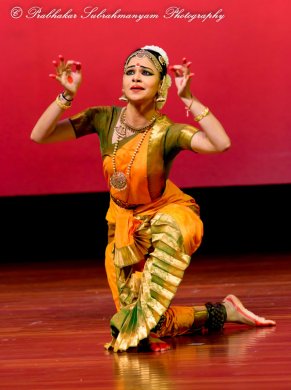
|   |

|   |
Sangam Arts presents Navia Natarajan in Tradition and Transcendence - Priya Das e-mail: priyafeatures@gmail.com June 26, 2015 June 21, 2015 saw four classical dance forms of India coming together on stage to form the opening act ‘Nrittanjali’ at Cubberly Theater, Palo Alto, California. Megh Pallavi in Odissi was clearly the highlight, choreographed by guru Ratikant Mohapatra and superlatively rendered by Akhil Joondeph and Maya Lochana Devalcheruvu. ‘Euphoria’ showcasing Bharatanatyam, Kathak, Odissi and Kuchipudi in addition, was an inspired choreography by gurus Sayali Goswami (Kathak), Madhuri Kishore (Kuchipudi), Niharika Mohanty (Odissi) and Navia Natarajan (Bharatanatyam).  Presented by Sangam Arts, the evening’s theme, Traditions and Transcendence, was personified by the rising Bharatanatyam performer Navia Natarajan. She started with her own “Parashakti,” a piece that paid homage to the many-faceted Devi. Clad in a mustard costume, it seemed as though Navia channeled the Goddess into our midst. She was powerful through her nritta - just like the Shakti, Navia lit up all the dimensions on stage with her emphatic movements. She was graceful through her abhinaya, which was brought home to us through excellent music. She was the epitome of wonderstruck bhakti when the dual vocals accompanied her deliberate, staccato choreography. A suggestion here is to use a dark color or a gradation using black for the background - the mustard did not show well against pastel lights at times. Swami Naan Undhan Adimai followed, where Navia chose to show the progression of the nayika’s love for Lord Shiva. While the sthayibhava was of centered maturity, the initial portrayal of a young girl’s innocent devotion followed by surprise at the intensity of her own feeling for the Lord was exquisite. The line Namamrata where the chanting of the Lord’s name alone brings peace to the nayika was masterfully presented. Navia showed an effervescent, impatient new love being calmed, and then a troubled mind being soothed. It was a dynamic varnam, showing at the same time, utmost attention to detail: no two ardhis were exactly the same, the lighting changed with the mood of the specific verse, the poses were simple yet evocative, the dancer and nayika getting progressively immersed. Navia has mastered the art of the narrative nritta - she innovatively emoted or followed the interaction between nayika and the Lord through nritta at times. Her dancing was contained when the pace was fast, her movements were big when the metric was slow, enabling the audience into an immersive experience. Amarushataka showed off another side of Navia’s talent, that of angikaabhinaya. The verse she chose had three episodes. The first was when “we were in love and inseparable,” where Navia’s body language was youthful, playful and confident. The next was when “I became your hatashapriyatama but you were my beloved.” Here, Navia transformed into a young woman uncertain of where she stood with her lover, frantic at the growing detachment on his part, and yet patient. The third line was “Now we are husband and wife, and I am left with a withdrawn heart.” Here, Navia became a lost woman, having given up on having a meaningful relationship with her beloved: the kilakau hasta was wrenched apart evocatively. Navia used the nayika tying her hair up as a measure of the state of emotion, energetic at first, progressing to deliberate, and then in a hopeless fashion. The part where she opens the door expectantly to be met with indifference, when her lovingly composed music is met with near disdain, and when the coffee is accepted mechanically really made the piece indelible. The only debate about this piece is whether it would have enhanced the experience if Navia had used a female vocalist. The last was Agni which was presented in three Acts. Act 1 was Fire as Creation. Navia was the Sun God, the golden ray, the deer, the lotus, the creeper, each individually etched so as to bring them to life, as the theme suggested. Act 2 was about Fire as annihilation and rebirth. Here Navia was at once the scorching fire and the scorched earth, even as she arose as a tiny sapling from the ashes. If these two Acts were brilliant, Agni Act 3 was choreography and execution par excellence, which was about the fire of creativity in an artist. Navia showed it as a tiny spark at the nabhi pulsating and growing till “it fans out at the heart.” Her narrative jathis progressed from hesitant movements to slow strength, to a steady force to finally a powerful energy- the hastas, laya, gati, angikaabhinaya were sensitively tuned to each progression. The culmination in an all-consuming fire was not overdone, which speaks volumes about Navia’s maturity as a choreographer. Navia is certainly on her way to become a consummate performer: not just in her dancing and sensitive understanding of the subject matter, but also instinctive stage presence she exudes along with the arrangement of music. The interludes with multiple vocals were used intelligently and to great impact. A big thank you to Usha Srinivasan of Sangam Arts for presenting this talent to the discerning Bay Area audience. Priya Das is a writer based in San Francisco Bay Area, USA, covering extraordinary nuances of everyday life with a focus on the performing arts. She is a regular contributor to India Currents, a magazine reaching more than 170K readers on - and offline. Some of her writing is at priyafeatures.com |